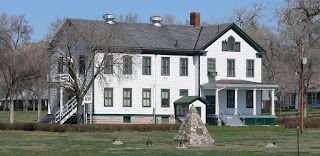Places: Fort Robinson, Nebraska
Per the terms of the Second Fort Laramie Treaty in 1868, the U.S. government established agencies for the various tribes that had been signatories to the treaty. The Oglala Lakota were initially placed at Red Cloud Agency on the North Platte River. However, in 1873, the Agency was moved to the White River, near what is now Crawford, Nebraska. Several thousand Lakota were settled at the Agency, but other bands of the Sioux Nation, along with Cheyenne, Arapahoe and others were still refusing to settle on reservations. A military camp was attached to the Agency, named Camp Robinson, after Lt. Levi Robinson, who'd been killed while on a wood-gathering detail. This camp was renamed Fort Robinson in 1878.
Camp and later Fort Robinson played a major part in the Sioux Wars from 1876-1890. Crazy Horse surrendered his band to Camp Robinson in May, 1877. Later, in September, while either being photographed or placed in a cell, Crazy Horse resisted and was killed by soldiers at Fort Robinson. In 1879, Cheyenne leader Morning Star/Dull Knife, lead the Northern Cheyenne on a breakout from Red Cloud Agency. The Cheyenne were resisting being resettled in Oklahoma. Soldiers from Fort Robinson hunted them down and killed men, women and children in what became known as the Fort Robinson Massacre. They recaptured Morning Star, but allowed him and his people to return to their homelands in Montana. In 1885, the 9th Cavalry of the Buffalo Soldiers was stationed at Fort Robinson, which had become a major training center and remount depot. By the end of WWI, Fort Robinson was the largest quartermaster remount depot in the United States, breeding the military's horses, which were fast becoming obsolete.
After the remount depot had been closed, the Fort was used as a K-9 training facility and later a German POW center. In 1947, Fort Robinson was formally closed and released to the US Department of Agriculture as a research facility on beef cattle. Most of the remaining buildings of the Fort were demolished at this time. The Nebraska State Historical Society began acquiring the property and opened a museum on the site. The USDA gave over the entire property to Nebraska in 1971 and moved elsewhere. The Fort Robinson State Park was established in 1956 and grew over time as the state acquired more historic buildings. Today, the park contains a blacksmith shop, a veterinary hospital, officers quarters, the guardhouse and adjutant's office and post cemetery. A museum occupies the site, which also include the area formerly occupied by the Red Cloud Agency, Camp Canby and some historic homesteads and ranches.
Camp and later Fort Robinson played a major part in the Sioux Wars from 1876-1890. Crazy Horse surrendered his band to Camp Robinson in May, 1877. Later, in September, while either being photographed or placed in a cell, Crazy Horse resisted and was killed by soldiers at Fort Robinson. In 1879, Cheyenne leader Morning Star/Dull Knife, lead the Northern Cheyenne on a breakout from Red Cloud Agency. The Cheyenne were resisting being resettled in Oklahoma. Soldiers from Fort Robinson hunted them down and killed men, women and children in what became known as the Fort Robinson Massacre. They recaptured Morning Star, but allowed him and his people to return to their homelands in Montana. In 1885, the 9th Cavalry of the Buffalo Soldiers was stationed at Fort Robinson, which had become a major training center and remount depot. By the end of WWI, Fort Robinson was the largest quartermaster remount depot in the United States, breeding the military's horses, which were fast becoming obsolete.
After the remount depot had been closed, the Fort was used as a K-9 training facility and later a German POW center. In 1947, Fort Robinson was formally closed and released to the US Department of Agriculture as a research facility on beef cattle. Most of the remaining buildings of the Fort were demolished at this time. The Nebraska State Historical Society began acquiring the property and opened a museum on the site. The USDA gave over the entire property to Nebraska in 1971 and moved elsewhere. The Fort Robinson State Park was established in 1956 and grew over time as the state acquired more historic buildings. Today, the park contains a blacksmith shop, a veterinary hospital, officers quarters, the guardhouse and adjutant's office and post cemetery. A museum occupies the site, which also include the area formerly occupied by the Red Cloud Agency, Camp Canby and some historic homesteads and ranches.




Comments
Post a Comment